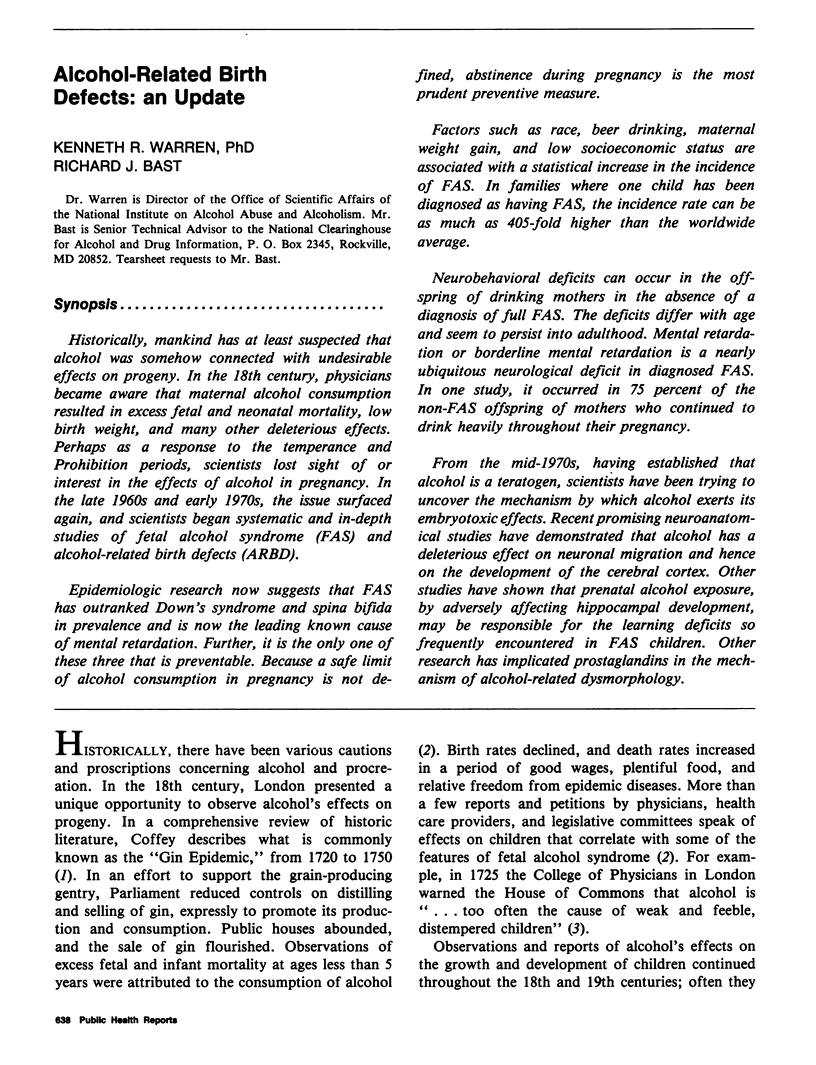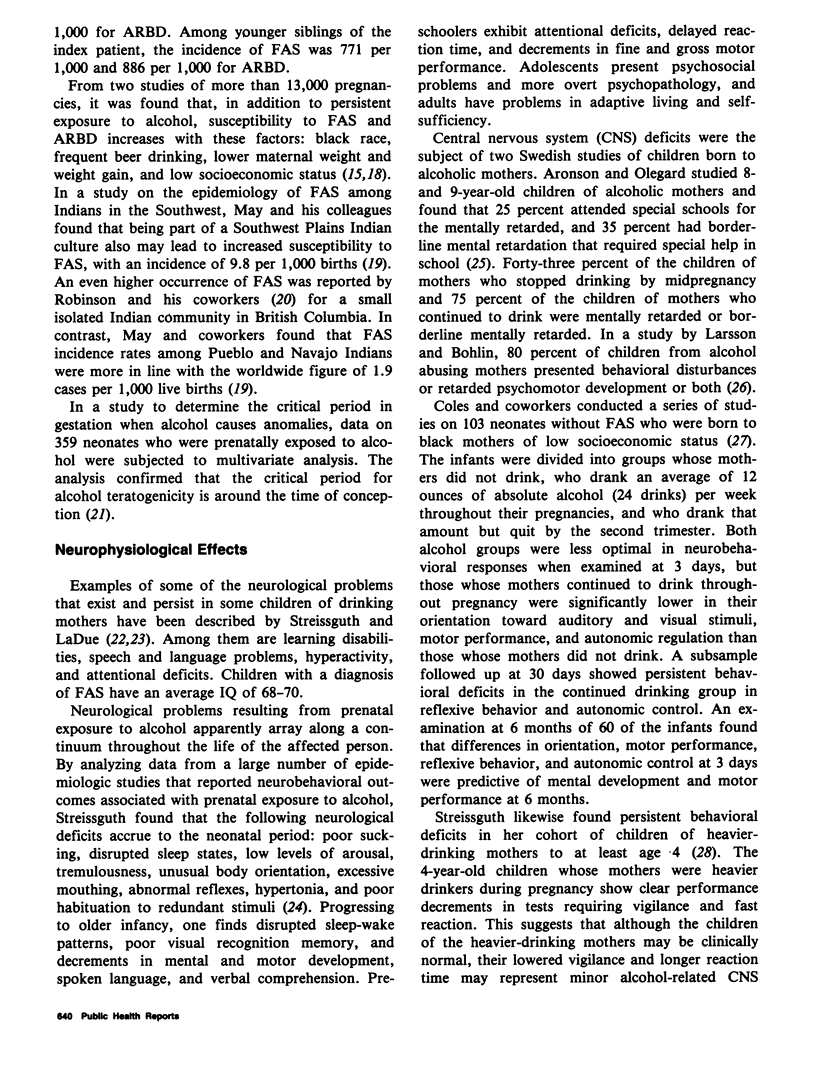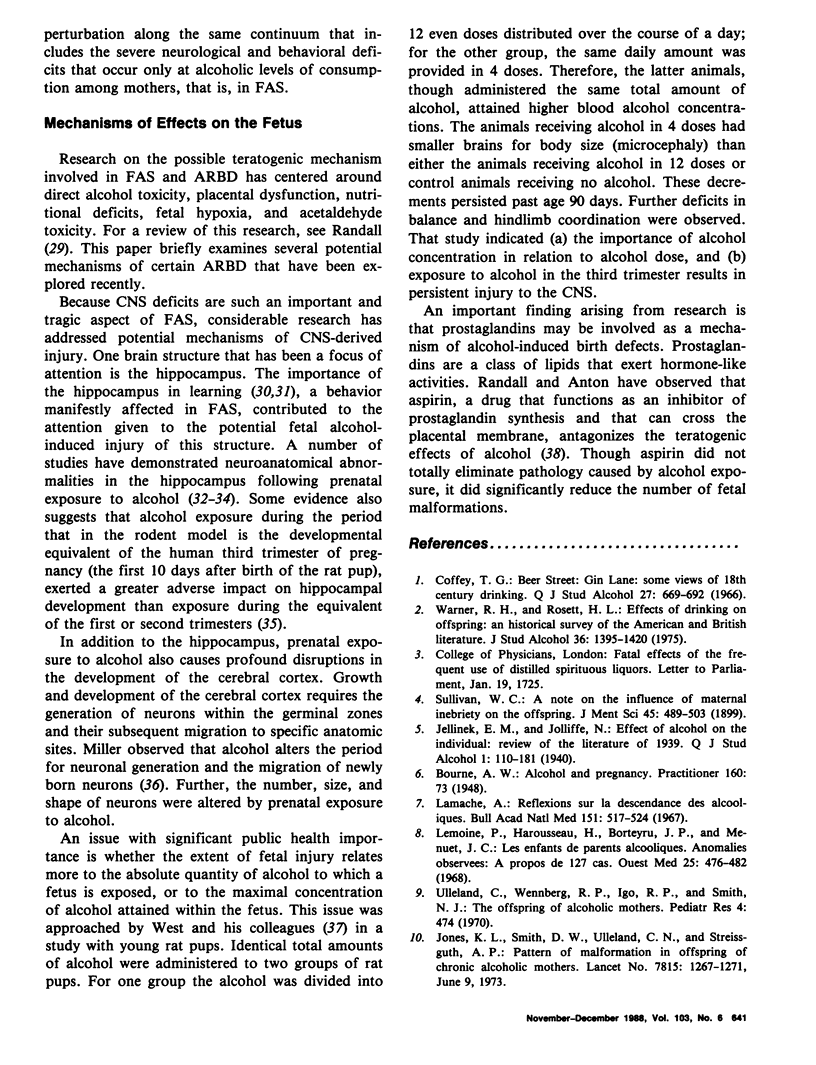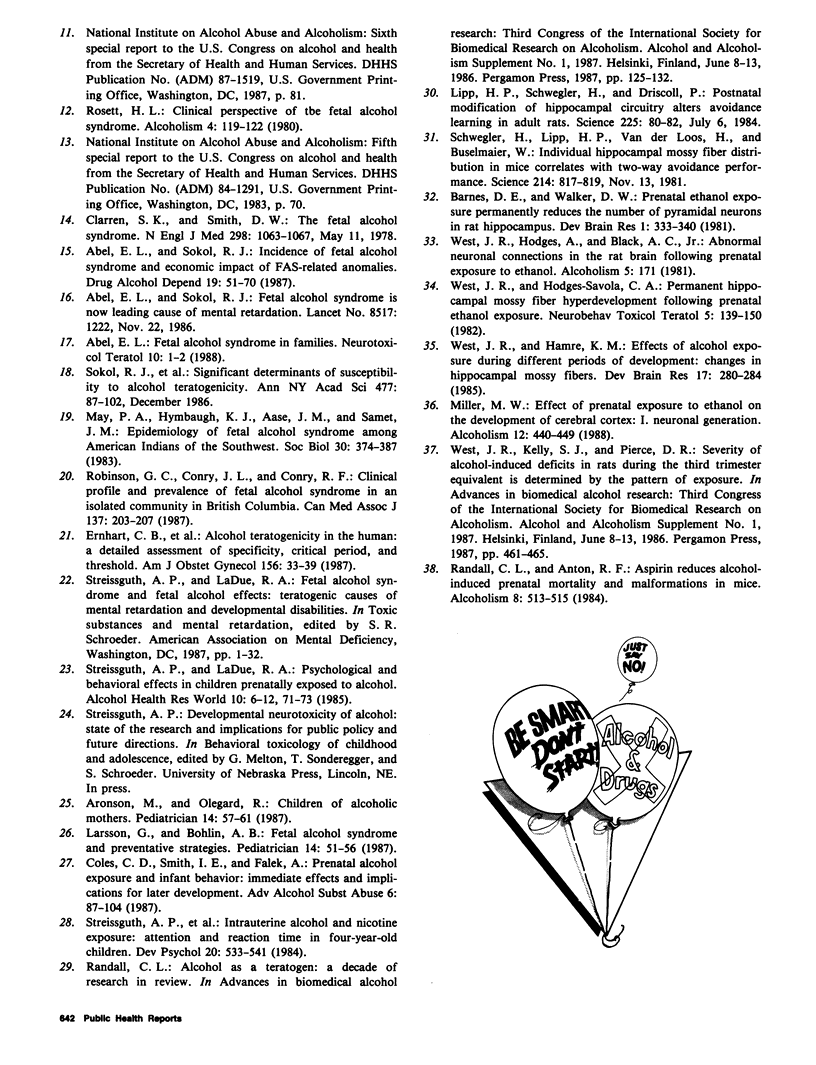Abstract
Historically, mankind has at least suspected that alcohol was somehow connected with undesirable effects on progeny. In the 18th century, physicians became aware that maternal alcohol consumption resulted in excess fetal and neonatal mortality, low birth weight, and many other deleterious effects. Perhaps as a response to the temperance and Prohibition periods, scientists lost sight of or interest in the effects of alcohol in pregnancy. In the late 1960s and early 1970s, the issue surfaced again, and scientists began systematic and in-depth studies of fetal alcohol syndrome (FAS) and alcohol-related birth defects (ARBD). Epidemiologic research now suggests that FAS has outranked Down's syndrome and spina bifida in prevalence and is now the leading known cause of mental retardation. Further, it is the only one of these three that is preventable. Because a safe limit of alcohol consumption in pregnancy is not defined, abstinence during pregnancy is the most prudent preventive measure. Factors such as race, beer drinking, maternal weight gain, and low socioeconomic status are associated with a statistical increase in the incidence of FAS. In families where one child has been diagnosed as having FAS, the incidence rate can be as much as 405-fold higher than the worldwide average. Neurobehavioral deficits can occur in the offspring of drinking mothers in the absence of a diagnosis of full FAS. The deficits differ with age and seem to persist into adulthood. Mental retardation or borderline mental retardation is a nearly ubiquitous neurological deficit in diagnosed FAS.(ABSTRACT TRUNCATED AT 250 WORDS)
Full text
PDF




Selected References
These references are in PubMed. This may not be the complete list of references from this article.
- Abel E. L. Fetal alcohol syndrome in families. Neurotoxicol Teratol. 1988 Jan-Feb;10(1):1–2. doi: 10.1016/0892-0362(88)90060-8. [DOI] [PubMed] [Google Scholar]
- Abel E. L., Sokol R. J. Incidence of fetal alcohol syndrome and economic impact of FAS-related anomalies. Drug Alcohol Depend. 1987 Jan;19(1):51–70. doi: 10.1016/0376-8716(87)90087-1. [DOI] [PubMed] [Google Scholar]
- Aronson M., Olegård R. Children of alcoholic mothers. Pediatrician. 1987;14(1-2):57–61. [PubMed] [Google Scholar]
- Barnes D. E., Walker D. W. Prenatal ethanol exposure permanently reduces the number of pyramidal neurons in rat hippocampus. Brain Res. 1981 Jun;227(3):333–340. doi: 10.1016/0165-3806(81)90071-7. [DOI] [PubMed] [Google Scholar]
- Clarren S. K., Smith D. W. The fetal alcohol syndrome. N Engl J Med. 1978 May 11;298(19):1063–1067. doi: 10.1056/NEJM197805112981906. [DOI] [PubMed] [Google Scholar]
- Coles C. D., Smith I. E., Falek A. Prenatal alcohol exposure and infant behavior: immediate effects and implications for later development. Adv Alcohol Subst Abuse. 1987 Summer;6(4):87–104. doi: 10.1300/J251v06n04_07. [DOI] [PubMed] [Google Scholar]
- Ernhart C. B., Sokol R. J., Martier S., Moron P., Nadler D., Ager J. W., Wolf A. Alcohol teratogenicity in the human: a detailed assessment of specificity, critical period, and threshold. Am J Obstet Gynecol. 1987 Jan;156(1):33–39. doi: 10.1016/0002-9378(87)90199-2. [DOI] [PubMed] [Google Scholar]
- Lamache A. Réflexions sur la descendance des alcooliques. Bull Acad Natl Med. 1967 Oct 17;151(25):517–521. [PubMed] [Google Scholar]
- Larsson G., Bohlin A. B. Fetal alcohol syndrome and preventive strategies. Pediatrician. 1987;14(1-2):51–56. [PubMed] [Google Scholar]
- Lipp H. P., Schwegler H., Driscoll P. Postnatal modification of hippocampal circuitry alters avoidance learning in adult rats. Science. 1984 Jul 6;225(4657):80–82. doi: 10.1126/science.6729469. [DOI] [PubMed] [Google Scholar]
- May P. A., Hymbaugh K. J., Aase J. M., Samet J. M. Epidemiology of fetal alcohol syndrome among American Indians of the Southwest. Soc Biol. 1983 Winter;30(4):374–387. doi: 10.1080/19485565.1983.9988551. [DOI] [PubMed] [Google Scholar]
- Miller M. W. Effect of prenatal exposure to ethanol on the development of cerebral cortex: I. Neuronal generation. Alcohol Clin Exp Res. 1988 Jun;12(3):440–449. doi: 10.1111/j.1530-0277.1988.tb00223.x. [DOI] [PubMed] [Google Scholar]
- Randall C. L., Anton R. F. Aspirin reduces alcohol-induced prenatal mortality and malformations in mice. Alcohol Clin Exp Res. 1984 Nov-Dec;8(6):513–515. doi: 10.1111/j.1530-0277.1984.tb05719.x. [DOI] [PubMed] [Google Scholar]
- Robinson G. C., Conry J. L., Conry R. F. Clinical profile and prevalence of fetal alcohol syndrome in an isolated community in British Columbia. CMAJ. 1987 Aug 1;137(3):203–207. [PMC free article] [PubMed] [Google Scholar]
- Rosett H. L. A clinical perspective of the Fetal Alcohol Syndrome. Alcohol Clin Exp Res. 1980 Apr;4(2):119–122. doi: 10.1111/j.1530-0277.1980.tb05626.x. [DOI] [PubMed] [Google Scholar]
- Schwegler H., Lipp H. P., Van der Loos H., Buselmaier W. Individual hippocampal mossy fiber distribution in mice correlates with two-way avoidance performance. Science. 1981 Nov 13;214(4522):817–819. doi: 10.1126/science.7292015. [DOI] [PubMed] [Google Scholar]
- Sokol R. J., Ager J., Martier S., Debanne S., Ernhart C., Kuzma J., Miller S. I. Significant determinants of susceptibility to alcohol teratogenicity. Ann N Y Acad Sci. 1986;477:87–102. doi: 10.1111/j.1749-6632.1986.tb40323.x. [DOI] [PubMed] [Google Scholar]
- Warner R. H., Rosett H. L. The effects of drinking on offspring: an historical survey of the American and British literature. J Stud Alcohol. 1975 Nov;36(11):1395–1420. doi: 10.15288/jsa.1975.36.1395. [DOI] [PubMed] [Google Scholar]
- West J. R., Hamre K. M. Effects of alcohol exposure during different periods of development: changes in hippocampal mossy fibers. Brain Res. 1985 Jan;349(1-2):280–284. doi: 10.1016/0165-3806(85)90155-5. [DOI] [PubMed] [Google Scholar]
- West J. R., Hodges-Savola C. A. Permanent hippocampal mossy fiber hyperdevelopment following prenatal ethanol exposure. Neurobehav Toxicol Teratol. 1983 Jan-Feb;5(1):139–150. [PubMed] [Google Scholar]


